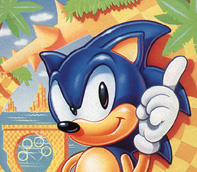

|
Get Ready For The Sonic Boom By Greg Gillis
DESPITE BRISK GENESIS SALES throughout the year, Sega still found itself in second place in the North American video game market at the end of 1990. Strong software support as well as favourable reviews for the Genesis system helped Sega finish ahead of their 16-bit rival NEC, but the vast majority of gamers still spent their time playing on Nintendo systems. 1991 would be the year that started to change. Sega wisely decided to focus their attention this year on preparing for battle against Nintendo's Super NES, scheduled for release in the fall. Electronic Arts' sports games had already begun to make the Genesis console the system of choice for fans of that genre, while Sega themselves released a stellar lineup of software throughout the year, including Castle Of Illusion Starring Mickey Mouse, Sonic the Hedgehog, Streets of Rage, Phantasy Star III, and Shining in the Darkness. Such was Sega's level of confidence in their new game system that they went so far as to have a side-by-side comparison of Sonic the Hedgehog and Super Mario World in their own booth at the 1991 Summer Consumer Electronics Show! By the end of the year, the future looked very bright for the Genesis system in North America. The Super NES had not managed to steamroll Genesis out of the way within a few months of its release (as many had predicted it would), nor had it received the avalanche of favourable press that Sega's system had been getting. Electronic Gaming Monthly, in particular, had not been particularly impressed with the Super NES software lineup available at its launch, and instead chose to bestow the Genesis system with their annual "Best System" award for the third year in a row. Indeed, complaints about the SNES' lack of backward compatibility, its relatively sluggish CPU, and the inexplicably third-rate case redesign it had been given for the western market could be found in almost all of the major gaming magazines of the day. In many ways, the release of the Super NES in North America probably came as more of a relief to Sega than anything else. There had been so much uncertainty and pent-up excitement amongst consumers about what Nintendo's successor to the NES would be like that by the time it was actually released the system couldn't possibly live up to all the hype. Sega's two year head start over Nintendo had apparently paid off. The future, it seemed, also belonged to Sega. The promise of a CD-ROM accessory for the Genesis some time in 1992, a device which would reportedly make Sega's console even more technically impressive than Nintendo's Super NES, was the icing on the cake for Sega fans. The general consensus by the end of 1991 in the gaming press was that the Genesis had already amassed a huge selection of great games, and with the aid of CD-ROM technology it could surpass anything Nintendo might produce in the near future. For the first time since the release of the NES, Nintendo had a real fight on its hands. Sega was leading the 16-bit revolution, and they weren't going anywhere without a fight! "Perhaps ... technology won't be the deciding factor in who wins the war of 16-bit game machines. As we've seen over the past five years, quality software and clever marketing are more likely to carry the day. " |
